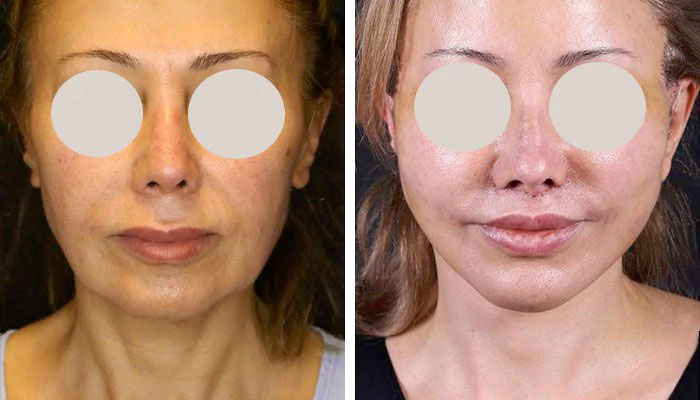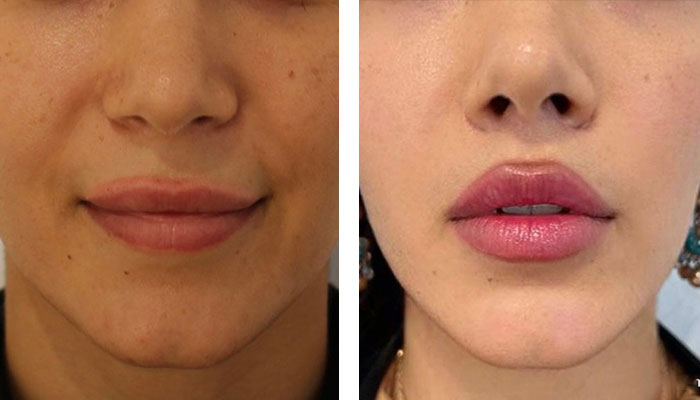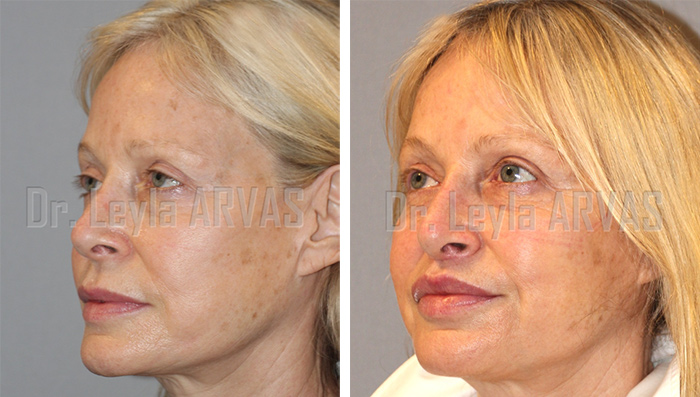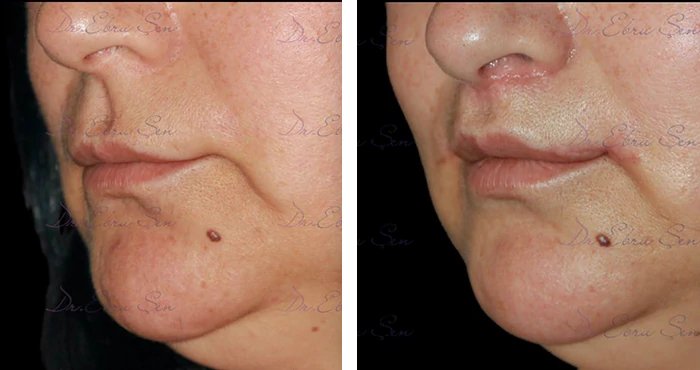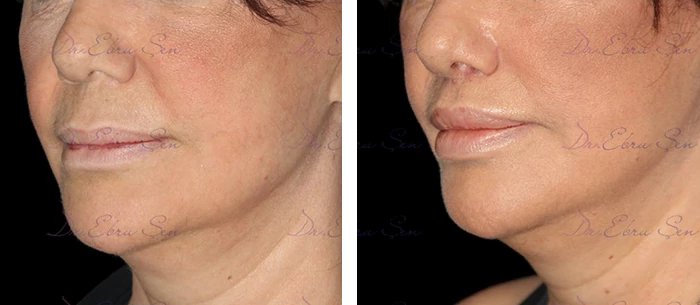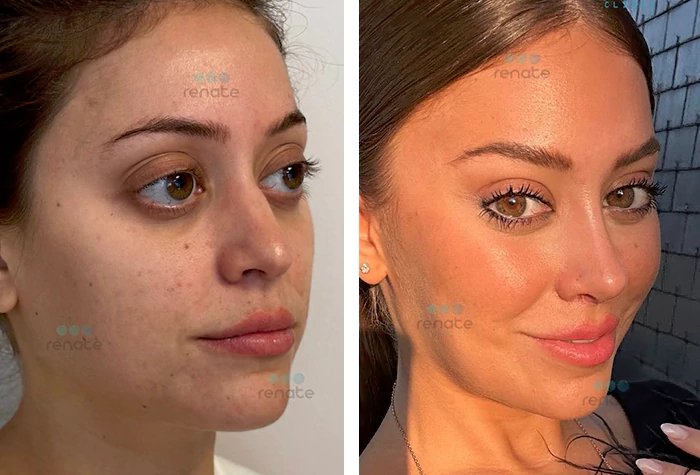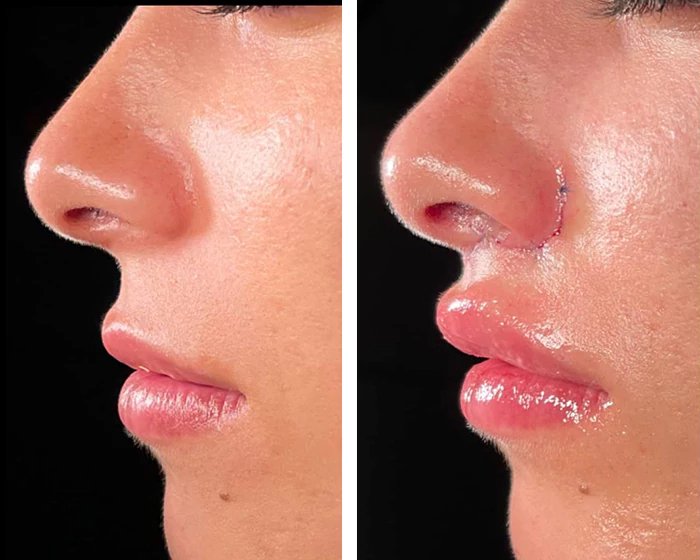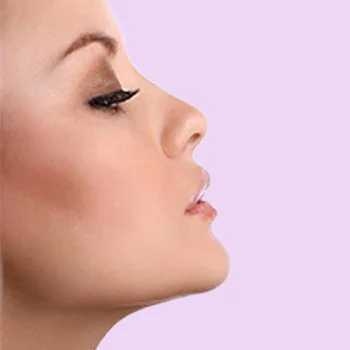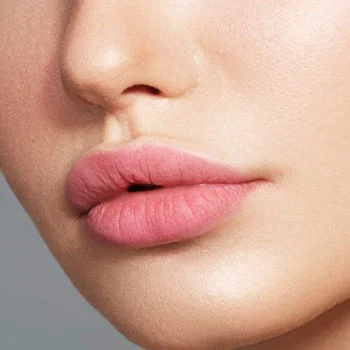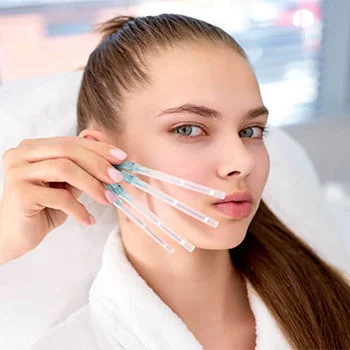What is lip lift?
A lip lift is a cosmetic surgical procedure that aims to enhance the appearance of the upper lip by shortening the distance between the lip and the base of the nose. It is designed to create a more youthful and balanced lip shape by increasing the amount of visible red lip and enhancing the definition of the lip border.
During the procedure, excess skin is removed from the area above the upper lip, and the remaining skin is lifted and sutured in a higher position. This can result in a more aesthetically pleasing upper lip and improved lip proportions. Lip lift surgery is typically performed under local anesthesia and can be done as an outpatient procedure.
Why do people have lip lifts?
People choose to undergo a lip lift for several reasons, including:
- Aging: As we age, the distance between the upper lip and the base of the nose can elongate, resulting in a less defined and less youthful lip appearance. A lip lift can help restore a more youthful and balanced lip proportion.
- Thin or "flat" lips: Some individuals naturally have thin or less defined lips, which may affect their overall facial harmony and aesthetics. A lip lift can create a fuller and more prominent upper lip, enhancing lip volume and definition.
- Lip asymmetry: Some people may have naturally uneven or asymmetric lips, where one side of the upper lip appears lower than the other. A lip lift can help correct this asymmetry and create a more balanced lip contour.
- Long philtrum: The philtrum is the vertical groove between the base of the nose and the upper lip. A long philtrum can make the upper lip appear elongated or disproportionate. A lip lift can shorten the philtrum and create a more aesthetically pleasing lip-to-nose ratio.
- Desire for a more youthful and attractive smile: A lip lift can enhance the appearance of the smile by exposing more of the upper teeth when the lips are at rest. This can create a more youthful and attractive smile.
Who are good candidates for lip lift?
Good candidates for a lip lift procedure are typically individuals who:
- Have a long or elongated upper lip: Candidates with a long distance between the base of the nose and the upper lip may benefit from a lip lift to create a more balanced and proportionate lip-to-nose ratio.
- Desire a fuller and more defined upper lip: Individuals with naturally thin or less defined upper lips may choose a lip lift to enhance lip volume and create a more prominent and aesthetically pleasing upper lip.
- Have lip asymmetry: Candidates with uneven or asymmetric lips, where one side of the upper lip appears lower than the other, may consider a lip lift to correct the asymmetry and achieve a more balanced lip contour.
- Are in overall good health: It is important for candidates to be in good overall health, as this can contribute to a smoother and safer surgical experience and recovery.
- Have realistic expectations: Candidates should have realistic expectations about the outcomes of the procedure and understand that a lip lift can enhance the appearance of the lips but may not completely change their natural shape or structure.
- Are non-smokers: Smoking can impair the healing process and increase the risk of complications. Candidates are typically advised to quit smoking before and after the procedure.
- Have a consultation with a qualified plastic surgeon: The best way to determine candidacy for a lip lift is to have a consultation with a qualified plastic surgeon. They will evaluate your facial anatomy, discuss your goals and expectations, and provide personalized recommendations based on your individual case.
It is important to have a thorough discussion with a qualified plastic surgeon to determine if you are a suitable candidate for a lip lift procedure and to understand the potential risks, benefits, and expected outcomes.
How is a lip lift performed?
A lip lift is typically performed as an outpatient surgical procedure and involves the following steps:
- Anesthesia: The procedure can be performed under local anesthesia with or without sedation, or under general anesthesia, depending on the patient's preferences and the surgeon's recommendation.
- Incision: The surgeon will make an incision along the base of the nose, just beneath the nostrils. This incision is often referred to as a bullhorn or subnasal incision.
- Tissue removal: A precise amount of skin and tissue is removed from the area above the upper lip. The amount of tissue removed depends on the desired outcome and the patient's anatomy.
- Lip lift and suturing: The remaining skin is then carefully lifted and sutured into a higher position, creating a more lifted and youthful appearance. The sutures used may be absorbable or non-absorbable, depending on the surgeon's preference.
- Wound closure: The incisions are closed with sutures, and the surgeon may apply surgical tape or a dressing to protect the incision site.
- Postoperative care: After the procedure, the patient is typically monitored in a recovery area before being allowed to go home on the same day. The surgeon will provide instructions on postoperative care, including wound care, medication usage, and follow-up appointments.
It is important to note that variations in technique may exist among surgeons, and the specific approach may differ based on individual patient needs and surgeon preferences. Consulting with a qualified plastic surgeon is essential to understand the details of the lip lift procedure, its expected outcomes, and potential risks and complications specific to your case.
What are the different types of lip lifts?
There are several different types of lip lift procedures that can help enhance the appearance of the lips. The specific technique used will depend on individual aesthetic goals, anatomical considerations, and the expertise of the surgeon. Here are some common types of lip lifts:
Subnasal or bullhorn lip lift
This is one of the most popular types of lip lifts. It involves creating an incision just beneath the base of the nose, following the natural curve of the nostrils. A small strip of skin is then removed, and the remaining skin is lifted and sutured, resulting in a subtle upward lift of the upper lip.
Gull wing lip lift
In this technique, an incision is made along the vermillion border (the colored part of the lip) of the upper lip. A small wedge of skin is then excised, and the remaining tissue is lifted and secured, resulting in a more pronounced lift of the upper lip.
Corner lip lift
This procedure is focused on lifting the corners of the mouth to address a downturned or sad appearance. Incisions are made at the corners of the mouth, and a small amount of skin is removed to elevate the corners and create a more youthful and lifted look.
Italian lip lift
This technique involves making small incisions at the base of the columella (the area between the nostrils) and lifting the upper lip. It is often used to create a more defined cupid's bow and expose more of the upper teeth when smiling.
Upper lip roll-out lip lift
This approach involves making incisions along the vermillion border of the upper lip and rolling out the skin to increase the visibility and volume of the upper lip.
It is important to consult with a qualified plastic surgeon to determine the most suitable lip lift technique for your specific goals and anatomy. The surgeon will evaluate your unique needs and recommend the best approach to achieve the desired results while maintaining a natural and balanced appearance.
How to prepare for a lip lift procedure?
Preparing for a lip lift procedure involves several important steps to ensure a smooth surgical experience and optimal recovery. Here are some general guidelines to help you prepare:
- Consultation: Schedule a consultation with a qualified plastic surgeon who specializes in lip lift procedures. During the consultation, discuss your goals, expectations, and any concerns you may have. The surgeon will evaluate your facial anatomy, discuss the procedure in detail, and provide personalized recommendations.
- Medical evaluation: Undergo a thorough medical evaluation to assess your overall health. This may involve providing your medical history, undergoing blood tests, and possibly obtaining medical clearance from your primary care physician or any relevant specialists.
- Medications and supplements: Inform your surgeon about any medications, vitamins, or supplements you are currently taking. They will advise you on which medications to continue or discontinue before the procedure, as certain medications or supplements may increase the risk of bleeding or interfere with anesthesia.
- Smoking and alcohol: If you smoke, it is strongly recommended to quit smoking well in advance of the procedure, as smoking can impair healing and increase the risk of complications. Additionally, avoid consuming alcohol for a few days before the surgery, as it can also affect the body's response to anesthesia and healing.
- Pre-operative instructions: Follow any specific pre-operative instructions provided by your surgeon, such as fasting guidelines (usually no food or drink after midnight on the night before the procedure), avoiding certain skincare products, and showering with a special antibacterial soap before surgery.
- Arrange transportation and support: As the procedure is typically performed on an outpatient basis, arrange for someone to drive you home after the surgery, as you may be groggy from anesthesia. It may also be helpful to have someone available to assist you during the initial recovery period.
- Recovery supplies: Stock up on any supplies recommended by your surgeon, such as pain medications, antibiotics, ice packs, and dressings. Ensure you have a comfortable recovery area set up at home with extra pillows to elevate your head and facilitate healing.
- Follow pre-operative fasting guidelines: On the day of the procedure, strictly follow the fasting guidelines provided by your surgeon to minimize the risk of complications during anesthesia.
It is crucial to carefully follow your surgeon's instructions and ask any questions you may have during the preparation process. This helps ensure that you are well-prepared and informed for your lip lift procedure.
What to expect during the recovery period?
During the recovery period following a lip lift procedure, it is important to understand and follow your surgeon's specific postoperative instructions. While individual experiences may vary, here are some general expectations:
- Swelling and bruising: Swelling and bruising are common after a lip lift. It is expected to peak within the first few days and gradually subside over the following weeks. Applying cold compresses and keeping your head elevated can help minimize swelling.
- Discomfort and pain: You may experience some discomfort, tenderness, or pain around the incision site. Your surgeon will prescribe pain medication to manage any postoperative pain. It is important to take the medication as directed and report any excessive pain or unusual symptoms to your surgeon.
- Dressings and sutures: Your surgeon may place dissolvable or non-dissolvable sutures to close the incisions. Dressings or surgical tape may be applied to protect the incision site, and these may need to be changed regularly. Your surgeon will provide instructions on when and how to change dressings, if necessary.
- Eating and drinking: Initially, you may be advised to follow a soft food diet for a few days or weeks to allow for proper healing and minimize strain on the incisions. Your surgeon will provide specific instructions on when you can gradually resume a normal diet.
- Oral hygiene: It is important to maintain good oral hygiene during the recovery period. Your surgeon may recommend using a gentle mouthwash or saltwater rinse to keep the surgical site clean. Avoid brushing or flossing directly on the incision area until advised by your surgeon.
- Activity restrictions: You will be advised to limit physical activities, avoid strenuous exercise, and refrain from activities that may strain or stretch the lip area during the initial healing period. Follow your surgeon's instructions regarding when you can gradually resume normal activities.
- Follow-up appointments: Your surgeon will schedule follow-up appointments to monitor your progress, remove any non-dissolvable sutures, and assess the healing process. Attend these appointments as advised to ensure proper healing and address any concerns or questions you may have.
It is important to note that individual recovery experiences may differ, and it may take several weeks or even months to see the final results of a lip lift. It is essential to maintain open communication with your surgeon and follow their postoperative instructions to support a smooth recovery and achieve the best possible outcome.
What are the potential risks?
Like any surgical procedure, a lip lift carries potential risks and complications. While they are relatively uncommon, it is important to be aware of them. Some potential risks include:
- Infection: There is a risk of infection at the incision site, which can be minimized by following proper wound care instructions and taking prescribed antibiotics as directed.
- Scarring: While efforts are made to minimize scarring, there is a possibility of visible scarring at the incision site. Most incisions for a lip lift are strategically placed to be well-hidden within the natural creases or contours of the nose. Scarring can vary depending on individual healing.
- Poor wound healing: In some cases, the incision may heal poorly, resulting in delayed wound healing, wound separation, or widened scars. Following postoperative care instructions and maintaining good overall health can help minimize the risk of poor wound healing.
- Numbness or altered sensation: Temporary or permanent changes in sensation, including numbness or altered sensation in the treated area, may occur. Sensation typically improves over time, but in rare cases, it may be permanent.
- Asymmetry: Despite efforts to achieve symmetry, there is a possibility of slight asymmetry between the two sides of the upper lip following the procedure.
- Unsatisfactory results: While a lip lift can enhance the appearance of the upper lip, individual results may vary. It is important to have realistic expectations and communicate your desired outcome clearly with your surgeon during the consultation process.
- Allergic reactions: In rare cases, individuals may experience an allergic reaction to anesthesia, surgical tape, or other materials used during the procedure. Inform your surgeon of any known allergies or sensitivities beforehand.
- Hematoma or bleeding: Excessive bleeding or the formation of a hematoma (a collection of blood) at the surgical site is a potential risk. Your surgeon will take precautions to minimize this risk and provide instructions on how to manage it if it occurs.
It is important to discuss these potential risks and any specific concerns you have with your plastic surgeon during the consultation process. A qualified surgeon will provide detailed information about the risks, benefits, and expected outcomes of a lip lift procedure and help you make an informed decision.
How much does a lip lift cost?
The cost of a lip lift procedure can vary depending on various factors, including the geographic location, the experience and reputation of the surgeon, the complexity of the procedure, and any additional fees associated with the surgical facility or anesthesia.
On average, the cost of a lip lift procedure can range from $2,000 to $6,000. However, this is only an approximate range and can be higher or lower based on the factors mentioned above.
It is recommended to consult with a qualified plastic surgeon to obtain an accurate cost estimate for your specific case. During the consultation, the surgeon will evaluate your needs, discuss the surgical plan, and provide a breakdown of the costs involved. They will also inform you about any financing options or payment plans that may be available.
When considering the cost of a lip lift, it is essential to prioritize the experience, qualifications, and reputation of the surgeon, as well as the quality of the surgical facility and the level of postoperative care provided. Choosing a skilled and reputable surgeon ensures the best possible outcome and reduces the risk of complications.
What are non-surgical alternatives to lip lift?
If you are looking for non-surgical alternatives to a lip lift procedure, there are several options available that can enhance the appearance of the lips. These alternatives focus on adding volume, improving lip contour, and addressing specific concerns without the need for surgery. Some common non-surgical alternatives to a lip lift include:
- Dermal fillers: Injectable dermal fillers, such as hyaluronic acid-based fillers (e.g., Juvederm, Restylane), can be used to add volume and shape to the lips. Fillers can help improve lip contour, define the vermilion border, and enhance the overall appearance of the lips. Results are temporary and typically last several months to a year, depending on the specific filler used.
- Lip augmentation with fat transfer: In this procedure, fat is harvested from another area of the body (e.g., abdomen, thighs) and injected into the lips to add volume and improve contour. Fat transfer can provide longer-lasting results compared to fillers, as the injected fat can survive and integrate into the lips. However, multiple sessions may be required to achieve the desired outcome.
- Lip thread lift: This non-surgical technique involves using dissolvable threads to lift and contour the lips. The threads are inserted into the lips through tiny incisions, and they provide support and lift to the lip tissues. The procedure can help improve lip shape, volume, and overall appearance. Results are temporary, typically lasting several months.
- Lip micropigmentation: Also known as lip tattooing or cosmetic lip tattoo, this technique involves depositing pigments into the lips to enhance their color, shape, and definition. It can help create the illusion of fuller lips and improve symmetry. Lip micropigmentation is a semi-permanent solution, as the pigments gradually fade over time and may require touch-ups.
- Lip plumping devices: Various lip plumping devices, such as suction-based devices or electronic devices that use microcurrents, are available on the market. These devices work by temporarily increasing blood flow to the lips, resulting in a temporary plumping effect. However, the results are short-term and may last only a few hours.
When considering non-surgical alternatives, it is important to consult with a qualified aesthetic practitioner who can assess your specific needs and recommend the most suitable approach. They will discuss the benefits, limitations, and potential risks associated with each option to help you make an informed decision.
FAQs
Does a lip lift surgery hurt?
The procedure is typically performed under local anesthesia, which helps minimize pain during the surgery. After the surgery, there may be some discomfort, swelling, and tenderness in the treated area, which can be managed with prescribed pain medications.
Does a lip lift leave scars?
A lip lift procedure typically results in a scar. However, with proper surgical techniques and placement of incisions, the scars are usually well-hidden along natural contours and tend to fade over time.
Is lip lift a permanent procedure?
Yes, a lip lift procedure is considered permanent. It involves surgically altering the shape and position of the lips to achieve a desired lift. However, natural aging and changes in the skin over time can still affect the appearance of the lips.
What is the minimum age for a lip lift?
There is no specific minimum age for a lip lift procedure. The suitability for the procedure is determined on an individual basis, considering factors such as physical maturity, aesthetic goals, and overall health. It is important to consult with a qualified plastic surgeon to assess candidacy.
Can I eat or drink normally after a lip lift?
In the immediate post-operative period, you may be advised to stick to a soft or liquid diet for a few days to allow for proper healing and minimize strain on the incisions. As your recovery progresses, you will gradually be able to resume a normal diet. It is important to avoid hot and spicy foods, as well as foods that require excessive chewing or stretching of the lips until your surgeon gives you the go-ahead.


